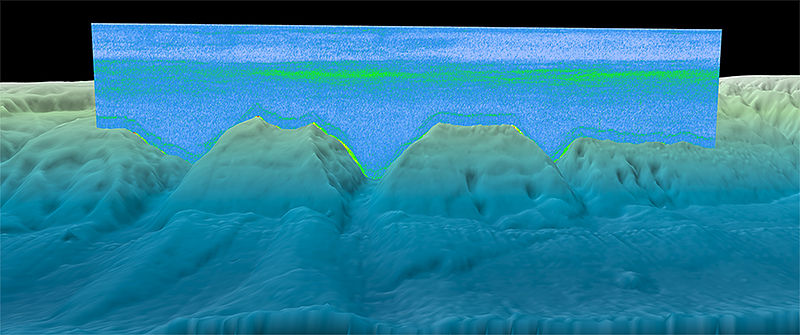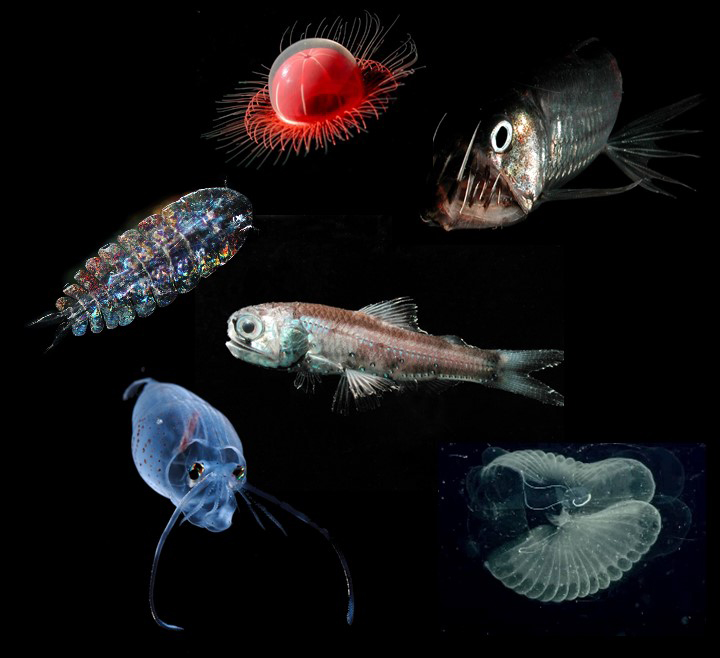Serendipitous data reveals a previously unknown ecosystem under Arctic ice
Fish gas bladders interfere with sonar, and we can use that interference to study Arctic fish stocks
NOAA via Unsplash
We know more about the surface of the moon than the bottom of the ocean. What about the space between the seafloor and the surface? You know, the ocean? On land, most animals are bound to the surface of the Earth, with only birds and bats dominating the skies. In contrast, the ocean is a three-dimensional environment, where most creatures can swim throughout its volume in all directions. Much of the usable space exists not at the bottom or near the surface, but somewhere in the middle.
In fact, somewhere between 65%-95% of all fish biomass lives in these middle depths. Most of it is not exploited by fisheries, but is invisibly important to us by serving as prey for human-targeted fish as well as many marine mammals and seabirds. With so much space available, the odds of bumping into these animals are low, so studying them can be difficult. In fact, for a long time the open seas were called "oceanic deserts" because we thought nothing lived there. Even now, we know very little about the fish and other creatures living in what is called the mesopelagic ("middle-sea") zone.
Some of these animals were discovered by accident. During World War II, sonar technicians noticed their signals bouncing off a dense layer that was shallower than they knew the seafloor to be. They called it a false seafloor, but didn't know what caused it. As the phenomenon turned up more frequently, technicians dubbed it the deep scattering layer (DSL) because of how it tended to scatter sound waves. It was only when data showed it moving up and down throughout the day that it was found to not have a physical cause, but a biological one: fish and other sea creatures. As hydroacoustic technology became more common, ships and submarines started encountering a DSL in locations all over the world. It was a fairly widespread phenomenon, but didn't occur everywhere. Now, scientists have discovered a DSL deep under the dense pack ice at the North Pole.

Image of a sonar scan taken in the North Atlantic. The backscattered signal (green) above the bottom is likely the deep scattering layer.
Elliot Lim, NOAA Okeanos Explorer via Wikimedia Commons.
The Central Arctic Ocean is difficult for biologists to study, simply because of limited access. It is a blind spot on our global maps of fish stocks. We didn't know whether there was a DSL there or not, simply because no one was ever able to look. The surface of the ocean is covered with dense pack ice which requires large icebreaking ships to traverse— an expense that is difficult to justify when searching for a DSL, especially when finding one is not guaranteed.
Serendipity struck when, in 2016, an icebreaking geophysical and oceanographic expedition collected comprehensive data on seismic activity, ice thickness, microplastics, and more. This expedition included recording hydroacoustic data in the waters under the North Pole. Biologists from Stockholm University realized they could piggyback on that work and repurpose the data to look for a DSL.
The scientists had to digitally remove the interference from the noises of the ship and cracking ice. Once that was done, they succeeded in finding evidence of a DSL under the North Pole, at 300-600 meters deep. The water temperature in this range was around 0.4 to 1.2 degrees Celsius — very close to freezing — and the total depth of the water reached 2,000-5,000 meters. The DSL appears to be comprised of both zooplankton and fish, although at a low abundance and small sizes.
The Arctic DSL was most dense under the North Pole, near 90 degrees North; the previous northernmost detection of a DSL had been at 82.1 degrees North. As the ship traveled to lower latitudes approaching Svalbard, Norway, a DSL was still present, although at a lower density.
In more accessible latitudes, the DSL is known to be the location of the largest animal migration on Earth, which is unique from most other known migrations. Every night, animals such as the nautilus move vertically in the water column, rising closer to the surface for better feeding opportunities. As the sun rises again, they descend back to the deep to avoid predators that are waking up. Unfortunately for them, mammals such as dolphins are skilled divers and can still reach this cornucopia of prey despite their daytime escape attempts. More research needs to be done to see whether vertical migration occurs in the Arctic DSL under the North Pole.

A pair of Nautilus pompilius feed on red bass bait deposited by an ROV on the sea floor, 703 m below the surface
A.J. Dunstan via Wikimedia Commons
A DSL was already known to exist in the Antarctic, and to support the diets of larger animals like penguins and seals. The Arctic DSL is likely to be a significant part of the food web as well, feeding larger animals like everyone's favorite sea unicorn, the narwhal.
The scientists are fairly confident that some of the animals observed were fish but because they didn't collect any samples, they were not able to confirm the species. Their best guess, given speeds of up to 13 centimeters per second and the observation of gas pockets that could be swim bladders, was that ice cod and polar cod were present, since they are common around the North Pole. It is also possible that some of the observed gas pockets belonged to invertebrates called siphonophores.
Unfortunately, climate change is quickly altering the ecosystems of the Central Arctic Ocean, primarily through the loss of sea ice. The rapid changes are likely to have cascading effects that will impact humans, like the decline of commercial fisheries. This is occurring before we even have a baseline understanding of the ecological structure and functions of the mesopelagic zone in the Arctic.

Organisms of the mesopelagic zone, including a viperfish, a copepod, a squid, a lanternfish, a jellyfish, and tunicates.
J.C. Drazen et al., via Wikimedia Commons.
This discovery represents innovation driven by curiosity. We know very little about Arctic fish populations because the environment is difficult to access. In a place where common types of fisheries surveys such as trawling are near impossible, scientists found an imaginative way to study fish. They utilized "data of opportunity" from work that had already been done to increase humanity's collective knowledge.
We've done all the easy exploring already. The parts of the ocean that are shallow and close to shore are mapped in even more detail than ever. The rest is going to take innovative technologies applied in intelligent ways. But the essence of science is curiosity, exploration, and discovery. So yes, we have a lot of searching to do through vast, seemingly empty stretches of water, but who knows what else we might find?